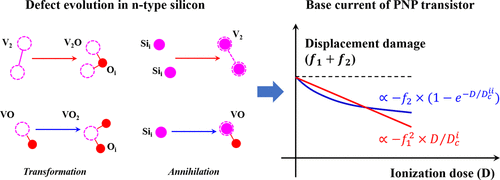当前位置:
X-MOL 学术
›
ACS Appl. Electron. Mater.
›
论文详情
Our official English website, www.x-mol.net, welcomes your feedback! (Note: you will need to create a separate account there.)
Origin of Irradiation Synergistic Effects in Silicon Bipolar Transistors
ACS Applied Electronic Materials ( IF 4.7 ) Pub Date : 2020-11-18 , DOI: 10.1021/acsaelm.0c00854 Yu Song 1 , Su-Huai Wei 2
ACS Applied Electronic Materials ( IF 4.7 ) Pub Date : 2020-11-18 , DOI: 10.1021/acsaelm.0c00854 Yu Song 1 , Su-Huai Wei 2
Affiliation

|
The practical damage of silicon bipolar devices subjected to mixed ionization and displacement irradiations is usually evaluated by the sum of separated ionization and displacement damages. However, recent experiments show a clear difference between the practical and summed damages, indicating significant irradiation synergistic effects (ISEs). Understanding the behaviors and mechanisms of ISEs is essential to predict the practical damages. In this work, we first make a brief review on the state of the art, critically emphasizing the difficulty encountered in previous models to understand the dose-rate dependence of the ISEs. We then introduce in detail our models explaining this basic phenomenon, which can be described as follows. Firstly, we show our experimental works on PNP and NPN transistors. A variable neutron fluence and γ-ray dose setup is adopted. Fluence-dependent “tick”-like and sublinear dose profiles are observed for PNP and NPN transistors, respectively. Secondly, we describe our theoretical investigations on the positive ISE in NPN transistors. We propose an atomistic model of transformation and annihilation of displacement-irradiation-induced V2 defects in p-type silicon under ionization irradiation, which is totally different from the traditional picture of a Coulomb interaction of oxide trapped charges in silica on charge carriers in irradiated silicon. The predicted novel dose and fluence dependences are fully verified by the experimental data. Thirdly, the mechanism of the observed negative ISE in PNP transistors is investigated in a similar way as in the NPN transistor case. The difference is that in n-type silicon, displacement-irradiation-induced VO defects also undergo an ionization-induced transformation and annihilation process. Our results show that the evolution of displacement defects due to carrier-enhanced defect diffusion and reaction is the dominating mechanism of the ISEs. Finally, we give a perspective on future investigations on the ISEs when the displacement and ionization irradiations are present simultaneously.
中文翻译:

硅双极晶体管中辐射协同效应的起源
通常通过分开的电离和位移损伤的总和来评估经受混合电离和位移辐射的硅双极器件的实际损坏。但是,最近的实验表明,实际损害与总损害之间存在明显差异,表明存在明显的辐射协同效应(ISE)。了解ISE的行为和机制对于预测实际损害至关重要。在这项工作中,我们首先简要回顾一下现有技术,重点强调先前模型在理解ISE剂量率依赖性方面遇到的困难。然后,我们将详细介绍解释此基本现象的模型,其描述如下。首先,我们展示了我们在PNP和NPN晶体管上的实验工作。采用可变中子注量和γ射线剂量设置。对于PNP和NPN晶体管,分别观察到与通量有关的“ t”样和亚线性剂量曲线。其次,我们描述了我们对NPN晶体管中正ISE的理论研究。我们提出了一个原子模型的位移和辐照诱导的V的转变和an灭2p型硅在电离辐射下的缺陷,这与传统的氧化硅俘获的电荷在被辐照的硅中的电荷载体上的库仑相互作用的传统图片完全不同。实验数据充分验证了预测的新型剂量和注量依赖性。第三,以与NPN晶体管类似的方式研究在PNP晶体管中观察到的负ISE的机制。不同之处在于,在n型硅中,位移辐照引起的VO缺陷也经历了电离诱导的转变和an灭过程。我们的结果表明,由于载流子增强的缺陷扩散和反应引起的位移缺陷的演化是ISE的主要机制。最后,
更新日期:2020-12-22
中文翻译:

硅双极晶体管中辐射协同效应的起源
通常通过分开的电离和位移损伤的总和来评估经受混合电离和位移辐射的硅双极器件的实际损坏。但是,最近的实验表明,实际损害与总损害之间存在明显差异,表明存在明显的辐射协同效应(ISE)。了解ISE的行为和机制对于预测实际损害至关重要。在这项工作中,我们首先简要回顾一下现有技术,重点强调先前模型在理解ISE剂量率依赖性方面遇到的困难。然后,我们将详细介绍解释此基本现象的模型,其描述如下。首先,我们展示了我们在PNP和NPN晶体管上的实验工作。采用可变中子注量和γ射线剂量设置。对于PNP和NPN晶体管,分别观察到与通量有关的“ t”样和亚线性剂量曲线。其次,我们描述了我们对NPN晶体管中正ISE的理论研究。我们提出了一个原子模型的位移和辐照诱导的V的转变和an灭2p型硅在电离辐射下的缺陷,这与传统的氧化硅俘获的电荷在被辐照的硅中的电荷载体上的库仑相互作用的传统图片完全不同。实验数据充分验证了预测的新型剂量和注量依赖性。第三,以与NPN晶体管类似的方式研究在PNP晶体管中观察到的负ISE的机制。不同之处在于,在n型硅中,位移辐照引起的VO缺陷也经历了电离诱导的转变和an灭过程。我们的结果表明,由于载流子增强的缺陷扩散和反应引起的位移缺陷的演化是ISE的主要机制。最后,


























 京公网安备 11010802027423号
京公网安备 11010802027423号